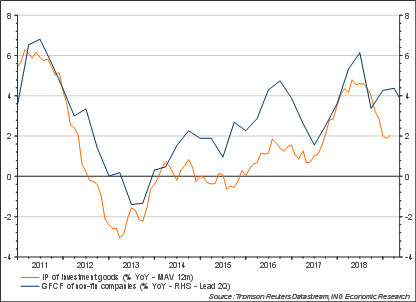France: Activity set to rebound in 1Q
Manufacturing production increased for the third month in a row in February, confirming a rebound at the start of 2019. Investment goods demand is strong thanks to high levels of capacity utilisation, and demand for consumer goods seems to be improving
Rebound in the making
In France, industrial and manufacturing production increased for the third month in a row in February. This confirms what recent activity indicators have been telling us: that a rebound is in the making in the first quarter. Manufacturing production rose by 1.1% month-on-month after a 0.7% increase in January. As in recent months, growth was concentrated in intermediate and investment goods, which are up 5.2% on the year. Even consumer goods production is slowly stabilising, with a much weaker contraction in February (-0.2% MoM vs -1.6% in January). These figures suggest that corporate investment was still dynamic in the first quarter while private consumption is recovering only slowly from a dip tied to the yellow vest crisis.
Corporate investments are still supporting manufacturing

Still cautious on 2019 GDP
As a whole, industrial production increased by 0.4%, weakened by the energy sector, and was up by 0.6% on the year in February. More importantly, 1Q19 should show the highest production growth figure since the end of 2017, confirming that the French economy is slowly exiting its soft patch since November. The Bank of France sentiment indicator, which was published earlier this week for March, confirmed that the first quarter should end on a positive note.
Capacity utilisation remained close to 80% in March and the European Central Bank has been insisting on the continuity of accommodative credit conditions for investments. Moreover, external demand has remained strong in the first quarter. We also think that the weak euro outlook for the first half of this year should continue helping French industry in coming months. This should contribute to the rebound in GDP growth expected for 1Q19, at 1.5% quarter-on-quarter (annualised). However, the support from external demand will probably fade in the second half of the year on the back of slowing international trade and Brexit stress, which is why we maintain a cautious stance as far as our 2019 GDP forecast is concerned (1.3%).
As far as Brexit is concerned, we reiterate that a 20% shock on British demand for French exports would have a negative impact on gross value-added. The impact on French growth would be similar to that of the yellow vest crisis (0.2 percentage points of GDP), but would affect different sectors. Some manufacturing sectors (like pharmaceutical product manufacturing) would be particularly affected, as well as some job-intensive services (read more on that here).
This publication has been prepared by ING solely for information purposes irrespective of a particular user's means, financial situation or investment objectives. The information does not constitute investment recommendation, and nor is it investment, legal or tax advice or an offer or solicitation to purchase or sell any financial instrument. Read more
Download
Download article